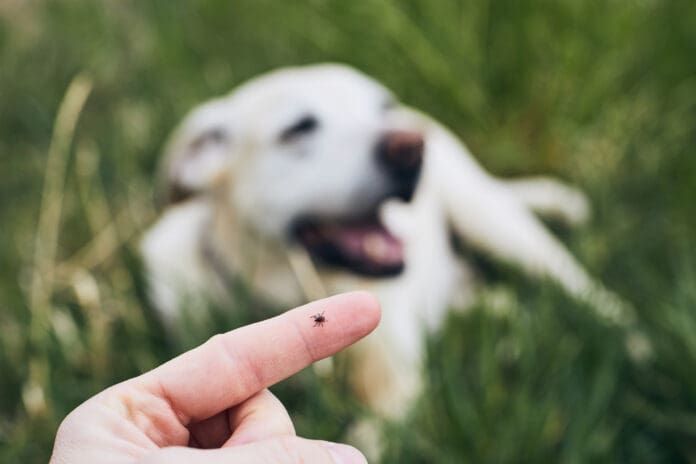Rocky Mountain spotted fever is a tick-borne disease that can infect dogs. A variety of ticks can carry the rickettsial bacteria that causes Rocky Mountain spotted fever in dogs, which means the illness has a wide range and is not limited to the Rocky Mountain area. The first case I ever dealt with was on Long Island, N.Y.
Signs of Rocky Mountain Spotted Fever
Symptoms that a dog has Rocky Mountain spotted fever are initially similar to many illnesses, including other tick-borne diseases. Joint pain, a drop in appetite, and fever are common. Some dogs will show gastrointestinal signs.
A sign more specific to Rocky Mountain spotted fever is blood vessel wall damage. Petechiae, or small hemorrhages, may be noticed on the conjunctiva of dog’s eyes or on the gums. Hemorrhages may be noticed in other areas as well.
These vasculitis problems due to Rocky Mountain spotted fever also can lead to damage in the kidneys, brain, and heart. Neurologic signs in your dog include tremors, a wobbly gait, and being hypersensitive when petted or touched.
Rocky Mountain spotted fever can be deadly, so early detection and treatment are important.
Tricky Diagnosis for Rocky Mountain Spotted Fever
Diagnosis can be tricky, since there is no quick screening test for Rocky Mountain spotted fever. A complete blood count and chemistry panel may suggest the disease is causing your dog’s symptoms. Advanced laboratory tests, such as polymerase chain reaction (PCR) tests, can identify acute cases. Immunofluorescent antibody tests can verify the infection but take weeks.
If your veterinarian suspects Rocky Mountain spotted fever in your dog, she will often prescribe doxycycline for a three-week period without an exact diagnosis. Whatever you do, give your dog the full prescribed three weeks of medicine. Some dogs have relapsed after a two-week treatment.
The silver lining with Rocky Mountain spotted fever is that dogs do seem to be immune to the disease after having the illness.
Preventing Rocky Mountain Spotted Fever
How can you prevent this disease? Tick control, tick control, tick control.
Depending on your situation, you may use monthly topicals, monthly oral medications, or some of the longer acting tick-control medications. During peak tick activity times (spring and fall), talk with your veterinarian about adding a spray before your walks, especially on your dog’s chest, neck, and head.
When you return from your walk, wipe down the dog with a lint roller, which can catch many ticks before they attach to the dog’s skin. This is especially useful on short-coated dogs. For heavily coated dogs, it doesn’t hurt to do a blow dryer check when you get home, blowing cool air on the dog’s coat so you can check his skin and check for ticks. Carefully remove any ticks you find. If you’re not sure what ticks look like, find out. In addition, consider making your yard non tick friendly.
Rocky Mountain spotted fever is part of the One Health initiative that is coordinating information among all health-care professionals, including doctors and veterinarians.





